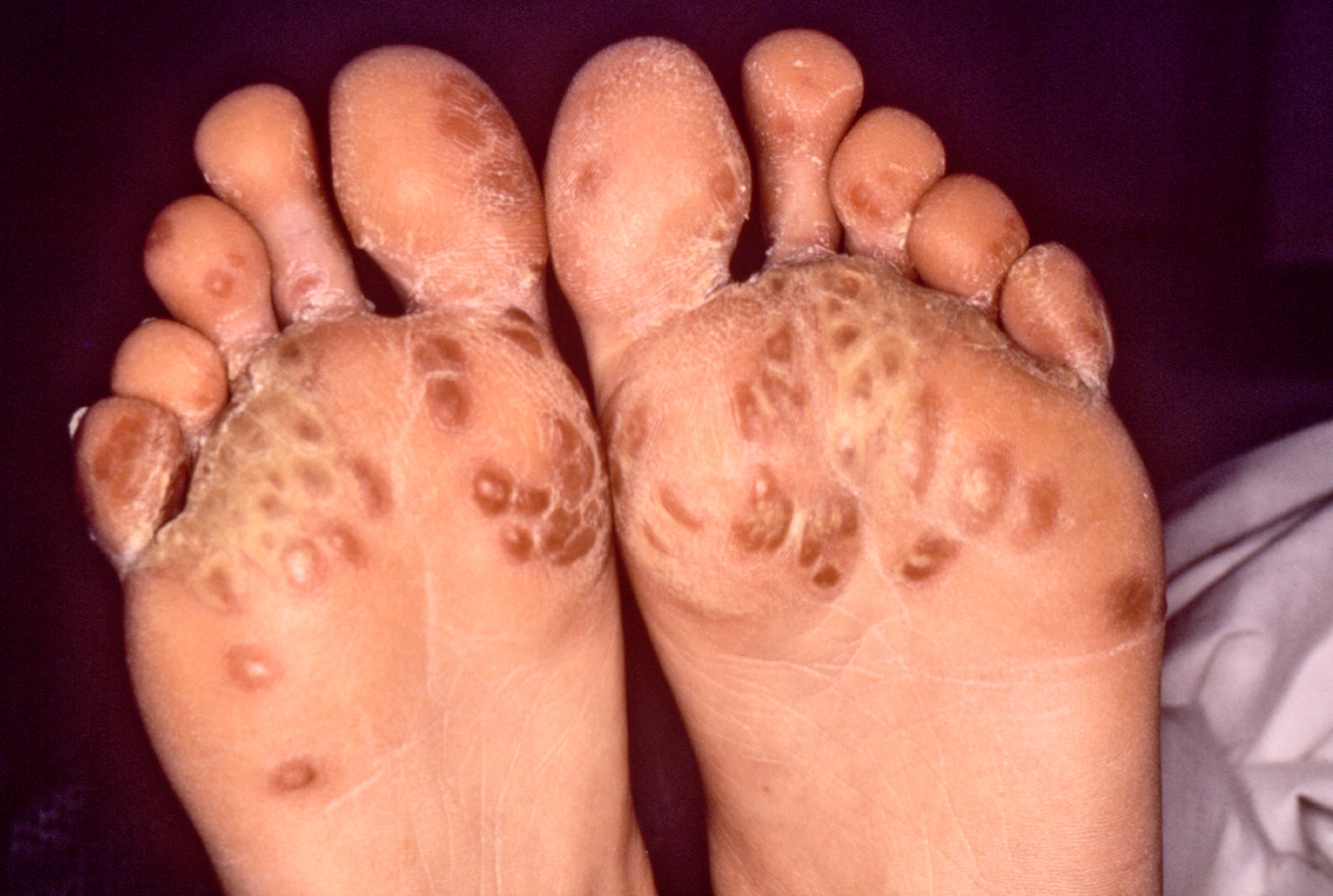Epidemiology
- Genetic predisposition and association with HLA-B27
- Commonly affects young men
Etiology
Postinfectious autoimmune disorder
- Posturethritis: after infection with Chlamydia (common) or Ureaplasma urealyticum
- Postenteritis: after infection with Shigella, Yersinia, Salmonella, or Campylobacter
Pathophysiology
Clinical features
Tip
The clinical manifestations are caused by immune complexes involving bacterial antigens. However, it does not represent disseminated infection, and joint aspirates are sterile (ie, it is a ‘reactive’ not infectious arthritis).
- Recent UTI or GI infections
- Musculoskeletal symptoms
- Oligoarthritis (sometimes polyarthritis)
- Acute onset
- Often asymmetrical with a migratory character
- Occurs predominantly in the lower extremities
- Sacroiliitis
- Enthesitis
- Dactylitis
- Oligoarthritis (sometimes polyarthritis)
- Extra‑articular symptoms
- Ocular: conjunctivitis, anterior uveitis
- Genital: urethritis, cervicitis, prostatitis
- Dermal: keratoderma blennorrhagicum, circinate balanitis

- Oral ulcers
- Symptoms from preceding infection
- Diarrhea
- Urogenital tract symptoms (dysuria, pelvic pain, prostatitis)
Mnemonic
Classic triad of reactive arthritis (seen in approximately one-third of affected individuals): “can’t see (conjunctivitis), can’t pee (urethritis), can’t climb a tree (arthritis)”.
Differential Diagnostics
BRANCH 1: ACUTE (< 6 weeks)
- 1a: Acute Monoarthritis (1 Joint)
- RED FLAG: Suspect Septic Arthritis? (Fever, chills, severe pain, erythema, warmth, ↓ROM)
- YES → URGENT ACTION: Hospitalize, Ortho/Rheum consult, Arthrocentesis STAT (Cell count & diff, Gram stain, Culture, Crystals), Blood cultures, CBC, ESR/CRP. Start empiric IV antibiotics AFTER aspiration.
- Suspect Crystal Arthropathy (Gout/Pseudogout)? (Sudden onset, severe pain, prior episodes, triggers)
- YES → Arthrocentesis (Look for MSU/CPPD crystals), Serum Uric Acid (can be normal acutely), CBC, ESR/CRP, X-ray (may show chondrocalcinosis in pseudogout).
- Suspect Trauma/Hemarthrosis? (History of injury, rapid swelling)
- YES → X-ray (rule out fracture), Consider Arthrocentesis (bloody fluid), CBC (if bleeding disorder suspected).
- Other Possibilities: Early presentation of oligo/polyarthritis, Lyme disease (rarely mono).
- RED FLAG: Suspect Septic Arthritis? (Fever, chills, severe pain, erythema, warmth, ↓ROM)
- 1b: Acute Oligo/Polyarthritis (≥2 Joints)
- Inflammatory Features Present?
- YES → Consider:
- Viral Arthritis: (e.g., Parvovirus B19, Hepatitis B/C, Rubella, HIV) - often symmetric, may have rash/flu-like prodrome. Workup: Viral serologies, LFTs, HIV test, CBC, ESR/CRP.
- Reactive Arthritis: (Post-GI/GU infection, often asymmetric oligoarthritis, +/- urethritis, conjunctivitis, enthesitis) - Workup: Stool/Urine culture (if indicated), Chlamydia testing, HLA-B27, ESR/CRP.
- Early Systemic Rheumatic Disease: (RA, SLE, PsA, SpA) - Workup: ESR/CRP, RF, Anti-CCP, ANA, Uric Acid, HLA-B27 (if SpA suspected), X-rays.
- Serum Sickness: (Drug reaction) - History, rash, fever.
- Lyme Disease: (Tick exposure history) - Lyme serology (may be negative early), ESR/CRP.
- Acute Rheumatic Fever: (Post-strep infection, migratory polyarthritis - rare in developed nations) - ASO titre, Throat culture, ECG.
- YES → Consider:
- Non-inflammatory Features Dominant?
- YES → Consider: Uncommon acutely unless widespread OA flare or multiple joints injured. Workup: X-rays, ESR/CRP (usually normal).
- Inflammatory Features Present?
BRANCH 2: CHRONIC (> 6 weeks)
- 2a: Chronic Monoarthritis (1 Joint)
- Inflammatory Features Present?
- YES → Consider:
- Chronic Infection: (TB, Fungal, Lyme) - Workup: Arthrocentesis (AFB/fungal stain/culture, Lyme PCR), PPD/IGRA, Chest X-ray, ESR/CRP, Synovial biopsy may be needed.
- Chronic Crystal Arthropathy: (Gout/Pseudogout) - Workup: Arthrocentesis (crystals), Uric Acid, X-ray.
- Spondyloarthritis (SpA): (Esp. knee/hip) - Workup: HLA-B27, ESR/CRP, Imaging (X-ray, MRI of SI joints if back pain).
- Pauciarticular JIA: (In younger patients).
- YES → Consider:
- Non-inflammatory Features Dominant?
- YES → Consider:
- Osteoarthritis (OA): (Commonest cause) - Workup: X-ray (joint space narrowing, osteophytes), ESR/CRP (usually normal).
- Avascular Necrosis (AVN): (Esp. hip, knee, shoulder; risk factors: steroids, alcohol) - Workup: X-ray (may be normal early), MRI is diagnostic.
- YES → Consider:
- Inflammatory Features Present?
- 2b: Chronic Oligo/Polyarthritis (≥2 Joints)
- Inflammatory Features Present?
- YES → Consider Systemic Rheumatic Diseases:
- Rheumatoid Arthritis (RA): (Symmetric small joints, hands/feet, morning stiffness >1hr, nodules) - Workup: ESR/CRP, RF, Anti-CCP (specific), X-rays (erosions), +/- Ultrasound/MRI.
- Spondyloarthropathies (SpA): (Incl. Ankylosing Spondylitis, Psoriatic Arthritis, Reactive, Enteropathic) - Often asymmetric, axial involvement (back pain), enthesitis, dactylitis, +/- skin/eye/GI symptoms. Workup: ESR/CRP, HLA-B27, X-rays (SI joints, spine), Skin/Nail exam, +/- MRI.
- Connective Tissue Diseases: (SLE, Scleroderma, Polymyositis) - Look for specific extra-articular features (rash, Raynaud’s, photosensitivity, organ involvement). Workup: ESR/CRP, ANA, ENA panel, C3/C4, CK, Urinalysis.
- Chronic Crystal Arthropathy: (Tophaceous Gout, CPPD) - Workup: Arthrocentesis, Uric Acid, X-rays.
- Vasculitis: (Less common cause of arthritis) - Look for systemic signs (purpura, neuropathy, organ dysfunction). Workup: ANCA, ESR/CRP, Urinalysis, Biopsy (if indicated).
- YES → Consider Systemic Rheumatic Diseases:
- Non-inflammatory Features Dominant?
- YES → Consider:
- Generalized Osteoarthritis (OA): (Hands - DIP/PIP/CMC1, Knees, Hips, Spine) - Workup: X-rays, ESR/CRP (normal).
- Fibromyalgia: (Widespread pain, fatigue, sleep disturbance, tender points - not true joint inflammation) - Diagnosis of exclusion, often normal labs/imaging. Consider TSH, Vitamin D.
- YES → Consider:
- Inflammatory Features Present?
Treatment
Prognosis
- Resolves spontaneously within a year
- High rate of recurrence